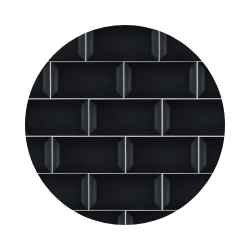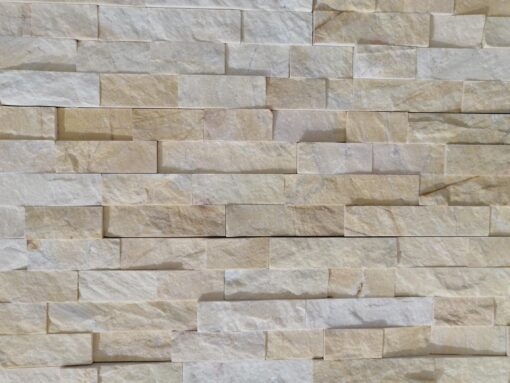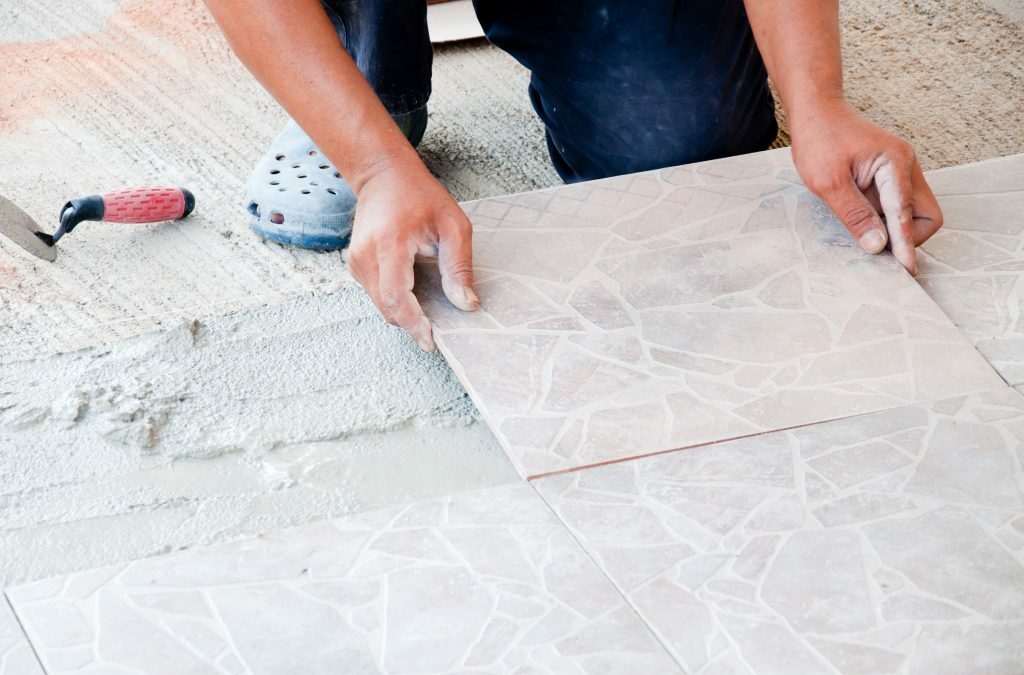
blog, commercial blog, floors, how to articles, walls
A regular question we get in Tiletoria showrooms is how to calculate how much tile you will need for your project. Whether you’re wanting to install your own tiled floor or you want to calculate the materials that you will need to budget for, it is important to know how to work out how much tile you need. The steps are the same regardless of whether you are doing a wall project or a floor.
With a measuring tape and some simple maths, you can estimate how much tile you need and how much the project is going to cost you.
What You’ll need:
- Paper
- A pen/pencil
- Measuring tape
- A calculator

Step 1: Measure the length of one side of the room.
The first step is to measure the floor length and width of the room you want to tile. Measure the length and height of the wall, if it is a wall project.
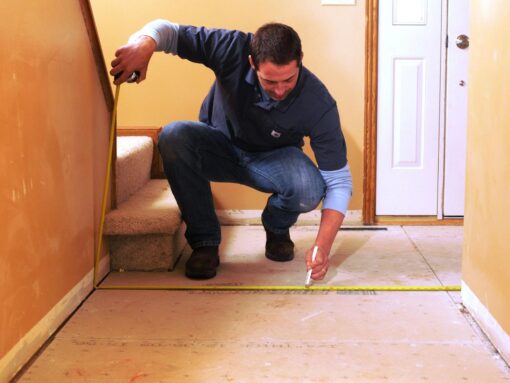
Step 2: Multiply the two measurements.
Once you have both measurements, the next step is to multiply them. Multiplying the length by the width provides you with the square meterage of the project area. For example, if the floor measurements of the room is 15 meters wide by 17 meters long, multiply 15 by 17. The square meter area of this room is 255 square meters in total.
Step 3: Based on this, determine the amount of tiles you’ll need.
Next is to use the above calculations to determine the amount of tiles needed. When buying tiles, they usually come in boxes, and you have to buy the whole box. Divide the total square meters of the room by the total square meters of the tile in the box to determine how many boxes of tiles you will need to buy. Lets say for our example, each box contains 15 square meters of tile. So, if you need 255 square meters, 15 goes into 255, 17 times, (255 ÷ 15) so you’ll need to buy at least 17 boxes.
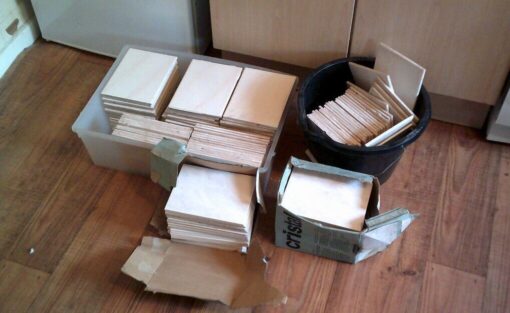
Pro Tip:
This is where the saying “rather be safe than sorry” comes into play. You should never buy just the amount of tile you need because you will always need extra tiles for any cuts, waste, breaks, and mistakes. To be on the safe side, you will need to multiply the square footage of the room by 10%, then add this amount to the total square area of the room. This is the total amount of square meterage of tiles you should buy. To continue with the above examples: 10 x 255 = 25.5, and 255 + 25.5 = 280.5, round up to 281. We’ll need 281 square meters of tile.
Another important reason to buy extra tiles is that often the style or colour of a particular tile gets discontinued after some time, and in the event that you need to replace a broken tile or two, you will need extras on hand to make the repairs. If you don’t, then to fix it, you will have to replace the entire floor.
In other words: Rather spend a little bit more up front to save money in the long run.
Important factors to consider:
Gap Size: Floor or wall tiles are typically installed with gaps between the tiles, which are commonly filled with grout. The average tile may look quite similar to the next tile however, they are often not uniform in shape and size, and would not fit properly if installed without any gaps. These gaps can range from anywhere between one-sixteenth of an inch to half an inch in size. Different sized tiles, materials, and design needs all affect the size of the gaps.
Size: Tile size can range anywhere from smaller mosaics, slab tiles and everything in between. Square sizes are the most popular, accessible, and easiest to install. While straight edge tiles are the most common, there are also unique tile shapes, but the installation of these is not as simple. Large tile sizes can make smaller rooms appear bigger, as well as more open and clean because there are fewer grout lines. However, installing larger tiles may results in more wastage, while installing smaller tiles can add texture to a room.
Material: There are a number of different types of tiles, including ceramic, porcelain, glass, quarry, stone and much more. Ceramic and porcelain tiles are the most popular, cost efficient, and come in a variety of different styles. Glass tiles, are not appropriate for flooring because they crack under pressure, are visually unique and interesting. These are most commonly used for kitchen and bathroom backsplashes. Quarry tiles have rough surfaces that are good for floors that require added grip, such as outdoors and in restaurant kitchens. Stone tiles include marble and granite, which provide unique and natural stone patterns, textures, and colours that are difficult to achieve using ceramics. They also offer the illusion of blending into grout edges, giving off an overall uniform look.
Other frequently asked questions we get regarding how much tile you need:
Question: What if the wall isn’t a simple rectangle and the room isn’t square?
Answer: If the space you want to tile is an unusual shape, draw a picture of the floor plan on a piece of paper, then separate the room into squares or rectangles. Measure each squared-off section separately, convert inches to feet (divide by 12; you’ll probably end up with a decimal), multiply the length and width of each space, then add all these numbers together to find the total square footage.
Question: What if I want to lay the tiles diagonally?
Answer: For tiles laid at a 45 degree angle, the overage or waste factor will be greater, so buy extra.
Question: How many square feet of tile comes in a box?
Answer: Most boxes hold 10 square feet, but check your box to make sure.
Question: Does the size or shape of the tile matter in my calculation?
Answer: No, only the square footage matters.
If you are still uncertain about the calculations, then pop by one of Tiletoria’s showrooms and chat to their sales team for advice.
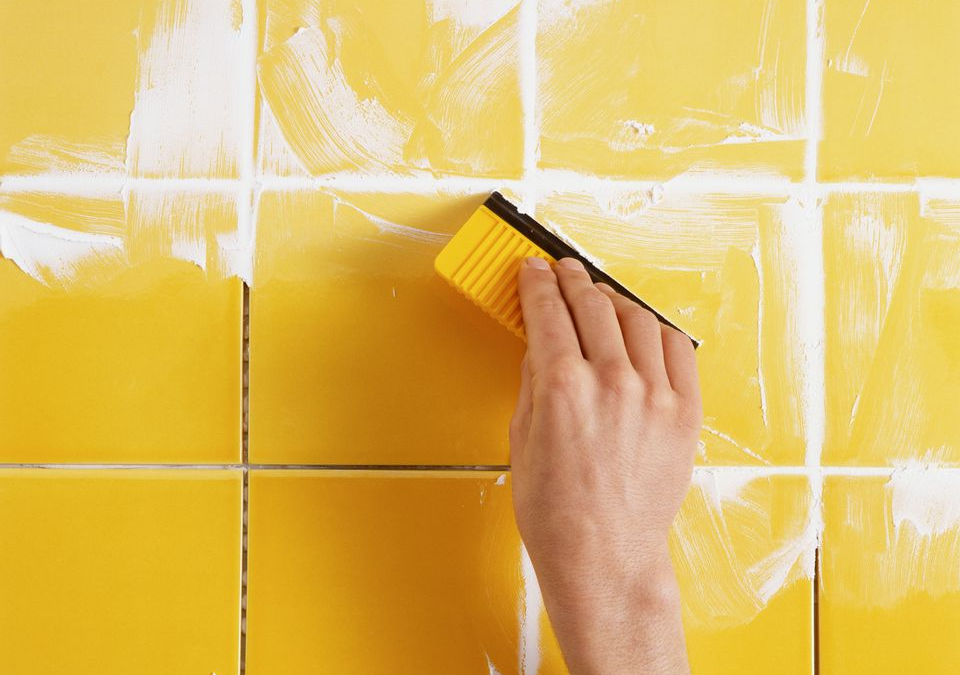
blog, commercial blog, floors, how to articles, walls
The tile grout colour you choose to use on your wall or floor plays an important part in the overall room design. You can choose between colours which are complementing or contrasting with your tiles. Alternatively, if you really want to create a unique space, you can go with a bold option and use non-standard grout colours.
Tile grouts come in a variety of colours from light to dark. Standard grout colours include; pure white, white, grey, black or beige, in a variety of different shades.

Contrasting Grout Colour
This grout is either darker or lighter than the corresponding tile. This will in effect frame each tile. The grout lines will become a feature of the overall tile design. Using small tiles with a darker grout can sometimes appear busy if used over a large area.
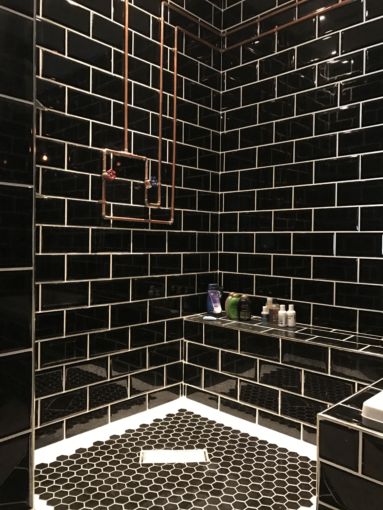

Complementary Grout Colour
This grout will be similar in colour to the tile. This will cause the tiles and grout lines to blend together. Effectively, blurring grout lines so that you see a consistency with the same colour throughout the room. This can be useful over small areas to keep the space less busy.
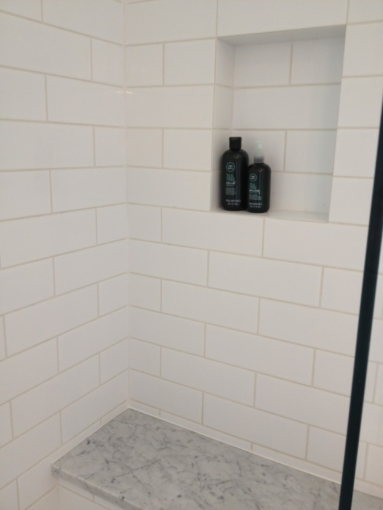
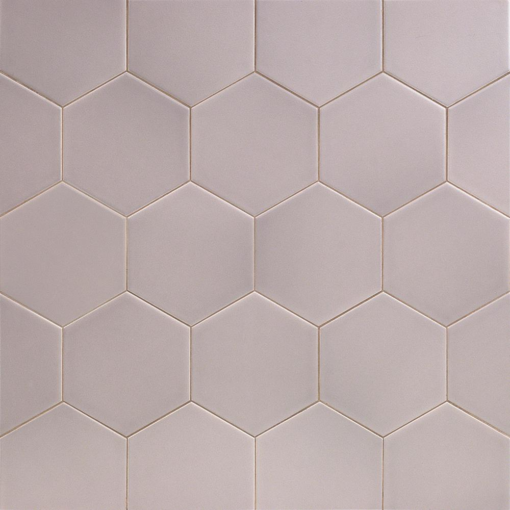
Colourful Grout
We commonly see tiles with white, gray, or black grout, but choosing colourful grout is a great way to make your tiles stand out. Tiles with coloured grout draws attention to the tile layout pattern, and creates a unique looking space, as opposed to a more seamless design.

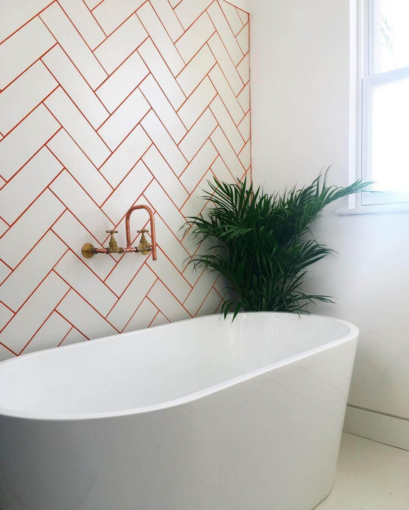
Pro Tip:
Avoid using pure white grout. Over time, using a pure white grout will start to show discolouration and mould quicker than darker shades of grout, especially in areas with high moisture and water. We recommend using an off white or grey grout as an alternative to avoid this from happening and for easier maintenance. We also recommend using a tile grout protector if you are using a light grout colour. It takes a bit more work afterwards protecting the grout, but the results are worth it. It is recommended to re-apply a grout protector every 2 years to prevent discolouration.
Should you need further help or assistance, pop into a Tiletoria showroom near you.
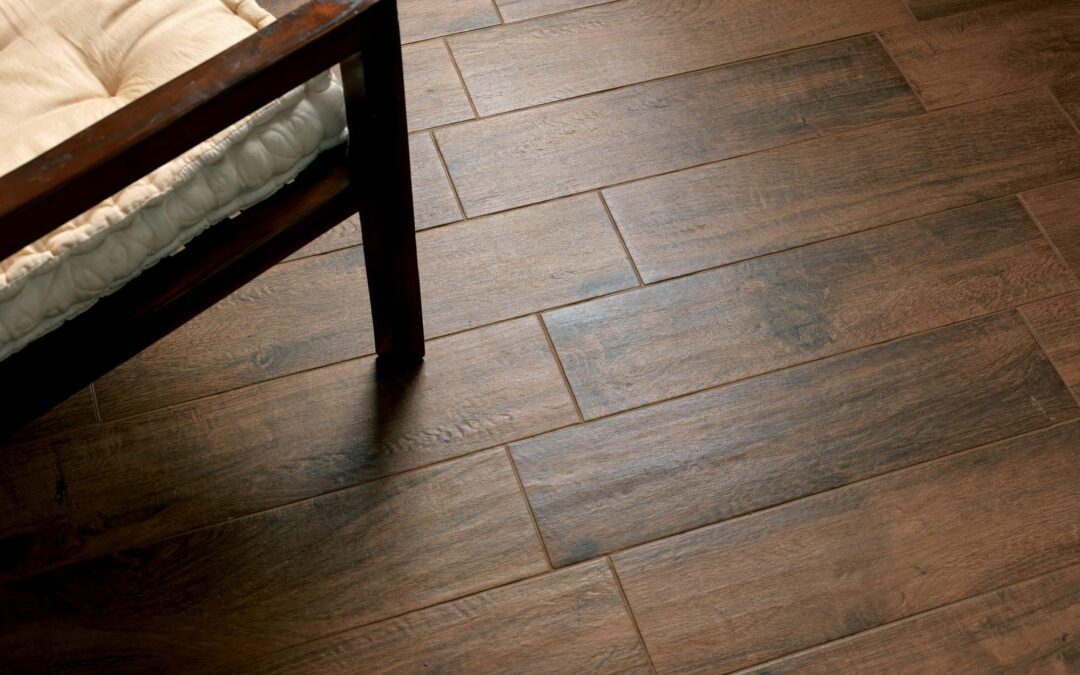
blog, floors, how to articles, woodlook
Wood-look tiles bring warmth and nature into our space, with their rich textures and rustic feel. They are a popular choice because they provide a neutral colour pallet from which to design any space desired. There is more hesitation towards using natural hardwood floorings, as they pricey, not eco-friendly, and have the ability to scratch and stain. Wood look ceramic and porcelain tiles combine the natural beauty of wood with the practicality, durability and affordability of tiles.

Left: Nebraska Meadow Porcelain Tile
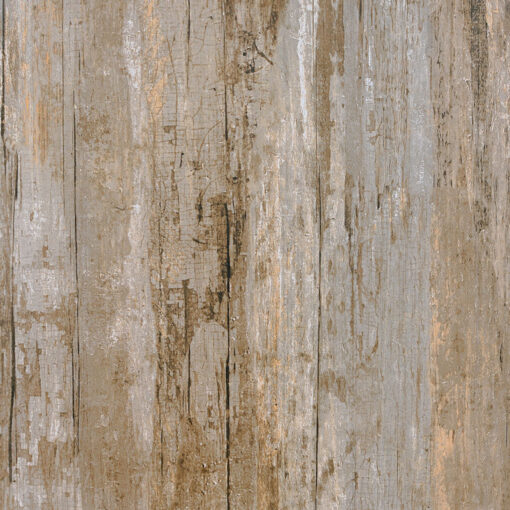
Left: Nebraska Tundra Porcelain Tile
Lets first get an understanding of how wood-look tiles are made
Professional grade ink-jet printing technology is used, which prints the look of wood onto the surface of ceramic or porcelain tiles. This is how these tiles look exactly like wood, mimicking the wood grain and coming in an array of different colours, textures and finishes.

Above: Arteak Pino Porcelain Tile
Where to use wood-look tiles
Wood look tiles are suitable for both walls and floors. Due to wood look tiles being porcelain and ceramic tile bases, these offer the advantage of being moisture and water-resistant, making them ideal for all areas of a home including; outdoors, bathrooms and kitchens.
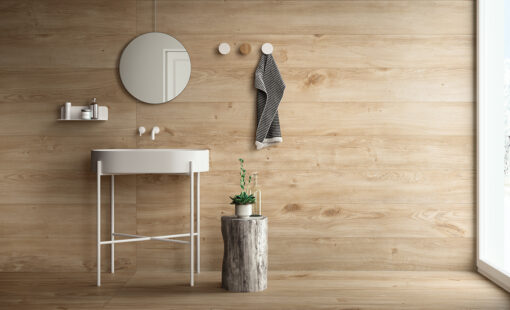
Above: Komi Natural Rectified Woodlook Tile
A matt glazed finish offers a more slip resistant installation. Porcelain wood look tiles are ideal for the patio, as porcelain is more resistant to water than ceramic. They also have the aesthetic appeal of wood without the needed maintenance, such as sanding, and sealing required with real wood decking.
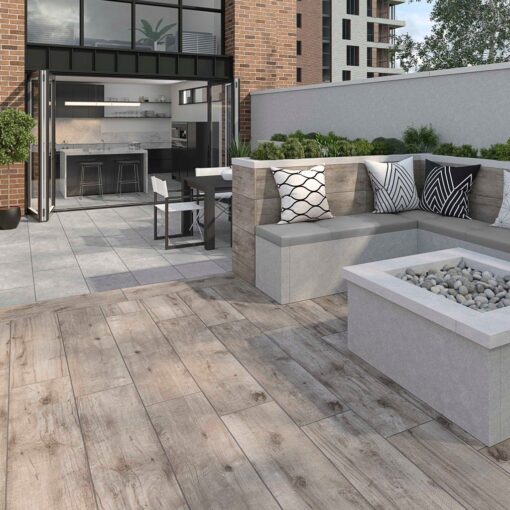
A unified look in your home is easy to achieve, by laying the same wood look tiles throughout. There’s no need to confine it to wet areas like kitchens and bathrooms, as it can work equally well in the living room or bedroom.
Now we will look at some inspiration on how to style and incorporate wood-look tiles into your home:
Wood look ceramic tiles can be used on both the floor and an accent wall to create a dramatic look and make a bold statement.
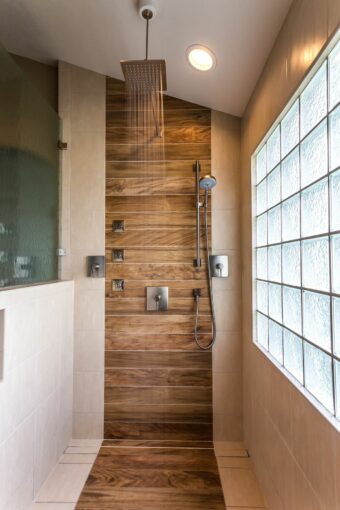
Working with tile means that you can very easily mix and match different tile sizes or types to create an interesting space, for example these two bathrooms below where wood look tiles are incorporated with pebble mosaic tiles.
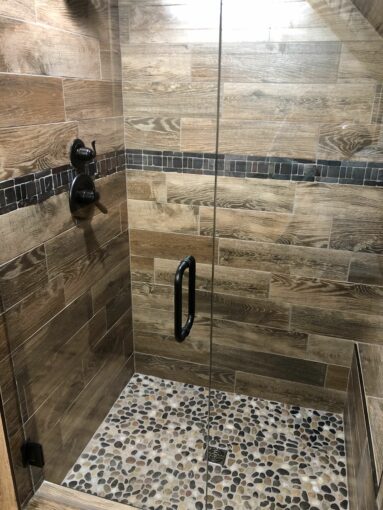
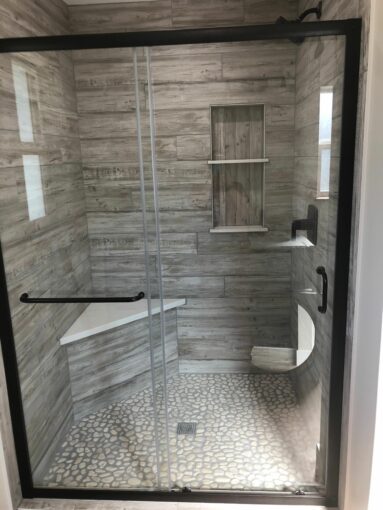
For an on-trend look, wood-effect tiles can be incorporated with decorative tiles. Colours and textures that contrast, are a perfect pairing.
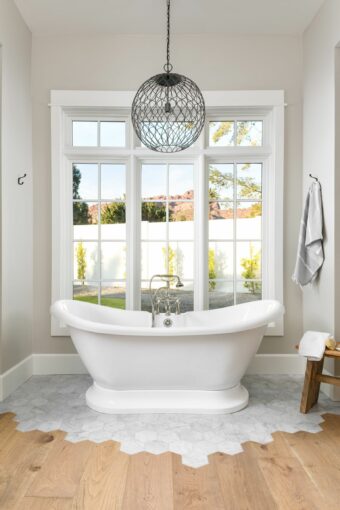
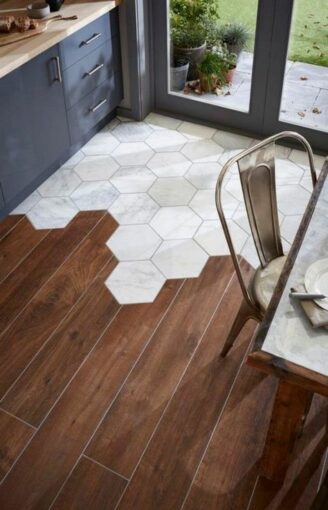
Creating a fireplace feature using wood look tiles is a great way to add warmth to your space and to turn a fire place into an attention-grabbing design feature in the living room.
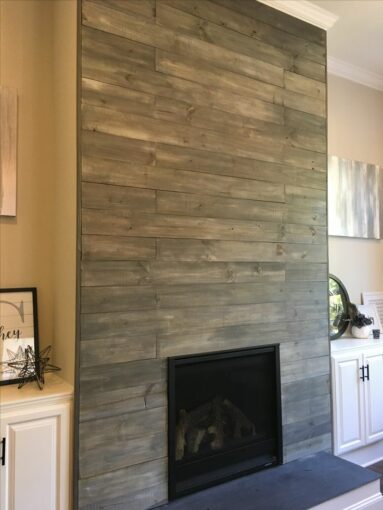
Using wood look tiles in a room does not mean you have to use the same tiles throughout. Different shades of wood look tiles can be incorporated into one space as pictured below, with a more earthy tone used on the walls and a lighter ash tone used on the floors.
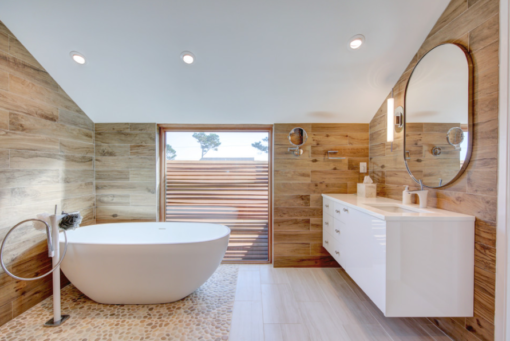
In the below pictures we can see how wood look tiles have been used to create statement walls in the bath and shower sections of the bathroom only. This is a great way to draw attention to a specific space in your bathroom, give your space that extra pop, as well as a trendy but homey feel.
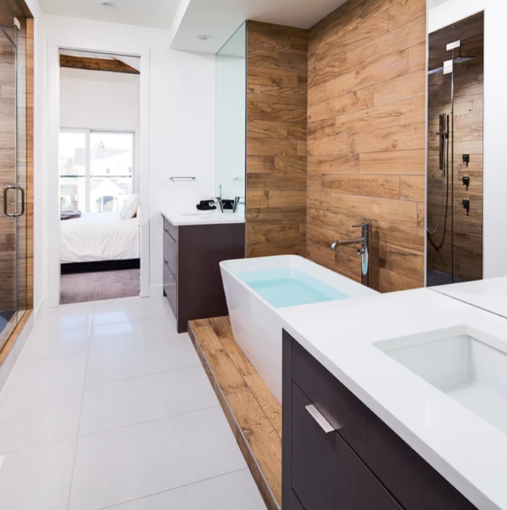
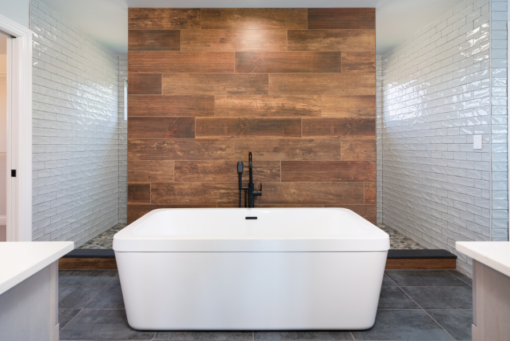
The availability of wood-look tiles has opened an array of design options. With wood-look tiles, you get the best of both worlds; the warmth of wood without the maintenance or other challenges of using real wood.
You can learn more about wood look tiles from the experts by visiting one of Tiletoria’s showrooms.

blog, walls
Subway tiles have become increasingly popular over the years, with these now being a top interior trend in 2022. Let’s take an in-depth look at what makes a subway tile a subway tile, and look at some creative ways these can be installed. We will also establish where these tiles are most commonly used.
First, we need to understand what exactly a subway tile is. The term “subway tile” typically refers to rectangular tiles (usually 3 x 6 inches). Made of ceramic, subway tiles are known for both their durability and their timeless style.
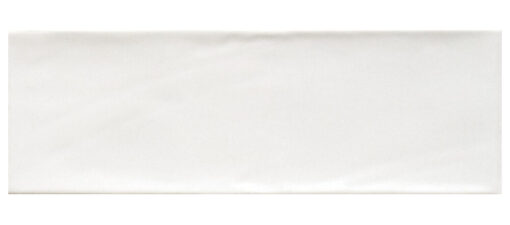
Above: bulevar white brillo ceramic wall tile
You might be wondering, why are subway tiles called subway tiles?
They were first used in New York subway stations in 1904, where designers were tasked with designing a surface that was low maintenance, bright, easy to clean, stain resistant and bacteria resistant. Additionally, the white and glossy design of the first subway tiles formed a highly reflective surface that helped create a safe, sanitary feeling for passengers.
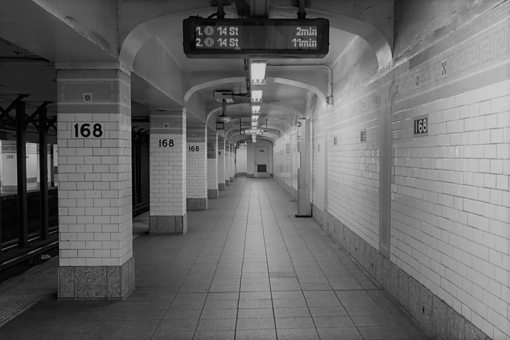
Now that we have established some general characteristics of subway tiles, let’s move on to the more exciting stuff! A key feature of modern subway tiles are the pushing of boundaries to find unique new ways to showcase their design. Often, this means altering the layout pattern.
Here are some creative ways to install subway tiles:
Vertically Offset Subway Tiles
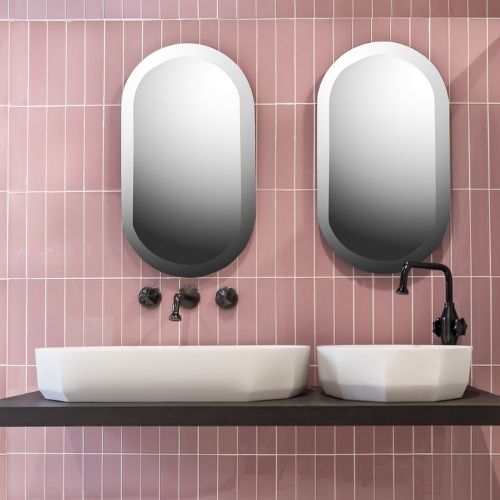
Above: Pink Vogue Glass Subway Tiles
By turning your subway tile on its side to create a vertically offset or stacked pattern, elongates a backsplash or wall and draws the eye upward.
Subway Tile in a Herringbone Pattern

Above: Lacche Curcuma Ceramic
Herringbone subway tile adds a sense of movement and can be laid at different angles to different effects. Laying herringbone tile may be slightly more complicated than laying a traditional offset pattern, however the results are worth the effort.
Subway Tile in a Diagonal Basket Herringbone Pattern
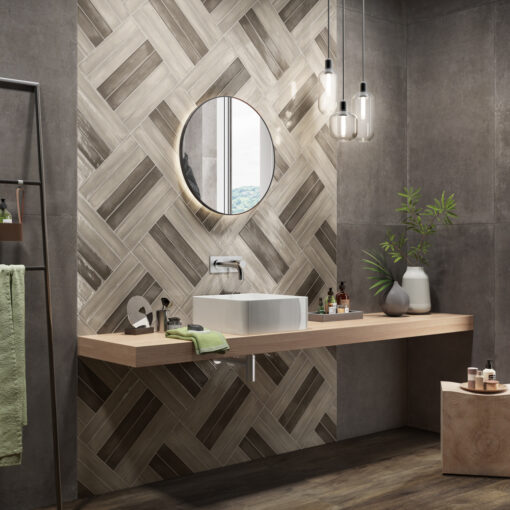
Above: Lacche Bruno Ceramic
You can also lay your subway tiles in a diagonal basket herringbone pattern, to create an interesting and stylish appearance. This is great for a feature wall or to create a trendy backdrop.
Change The Colour!
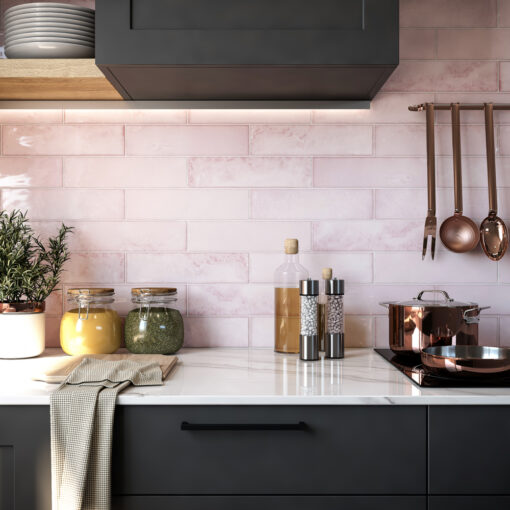
Above: Drop Pink Ceramic White Tile
Using colorful subway tiles can give your design a fun and modern twist. No colour is off the table!
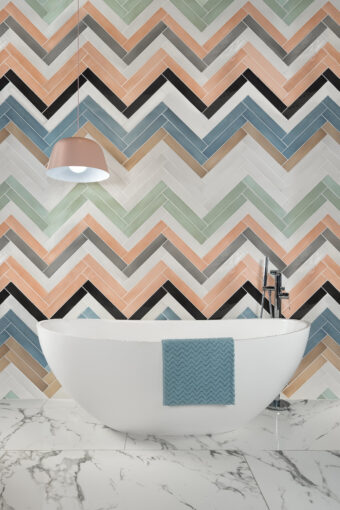
Above: Manacor Subway Ceramic Tile in multiple colours
If you can’t choose just one color for your subway tile, multi-colour subway tiles are for you! One trend is to sprinkle tiles of a different colour into your subway tile design in a random fashion, giving you a unique look, like the one pictured above.
Change The Dimensions
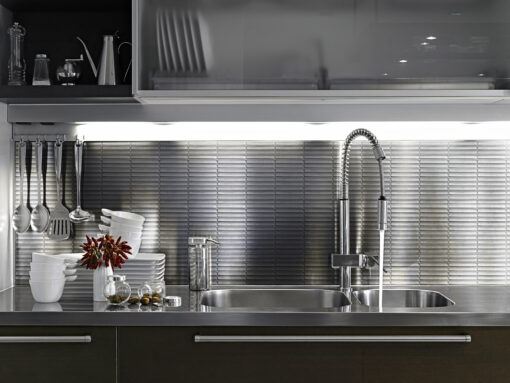
Above: autumn fairy speckled charcoal kit-kat tiles
Subway tile is typically 3 x 6 inches, but this backsplash proves that’s not a hard and fast rule. In a thinner and elongated size, we like to call these kit kat tiles.
Colour The Lines
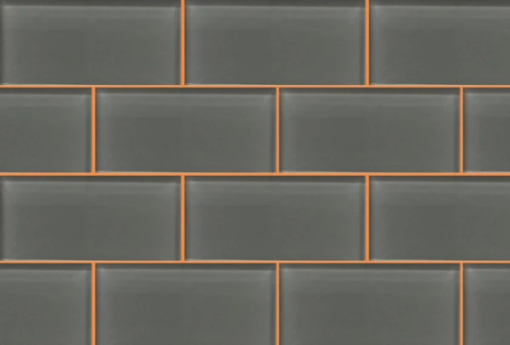
We commonly see subway tile with white, gray, or black grout, but choosing colorful grout is a great way to make your subway tiles stand out. Subway tiles with coloured grout draws attention to the tile layout pattern, whereas subway tile with matching grout creates a more seamless design.
Where subway tiles are most commonly used:
Subway Tile Backsplashes

Above: Lacche Ghiaccio Ceramic
Subway Tile Feature Walls
Feature walls can show off your subway tiles. This living space opts for a bright design, with our lacche salvia ceramic tiles, matched perfectly with an emerald pallet.
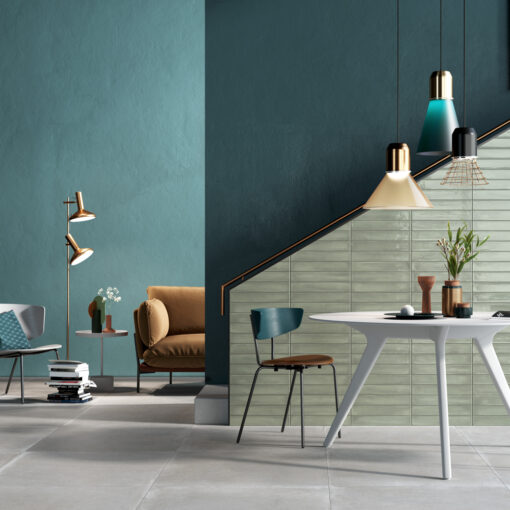
Above: Lacche Salvia Ceramic
Subway Tile Fireplace Surrounds

Fireplace surrounds can benefit from subway tiles as well. Ceramic tiles are flame-resistant, so you needn’t worry about heat harming your tiles.
Subway Tile Showers
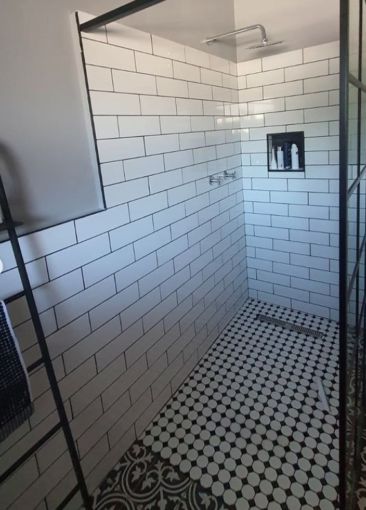
Above: Client bathroom using our essence white gloss ceramic wall tile
Subway tiles are a popular choice for showers. As mentioned above, these are water and stain resistant, easy to clean and durable.
Now it is easy to see why subway tiles are such a popular choice for interiors today, how they have endured over the years, and why they’re still used today.
Visit one of our showrooms for expert advise on subway tiles and follow us on our socials for even more creative subway tile designs to admire.
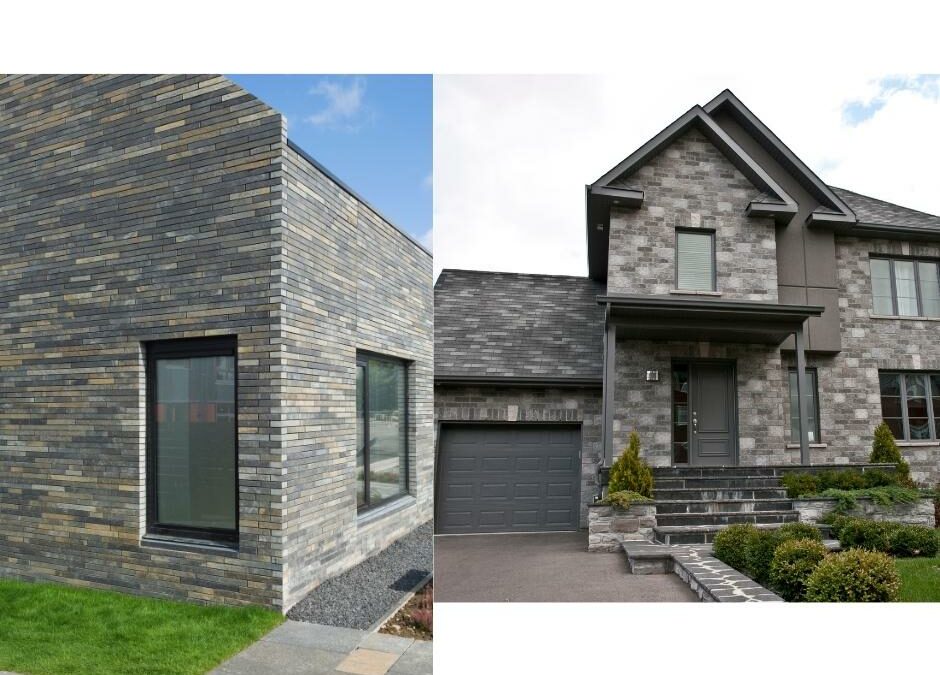
blog, commercial blog, outdoor
From a smart, understated finish to a bold, head-turning design, cladding can be used creatively to take your home or commercial property’s exterior to the next level. Stone cladding is a thin layer of stone that is used for the interior or exterior of a building, generally on top of a material that isn’t stone, such as concrete.
Whether you’re cladding the front of a house, an exterior wall, garden wall, summer house, or a commercial property, let’s look at some of the benefits of cladding products.

THE NATURAL BEAUTY OF STONE
The natural, unrivalled beauty of cladding is an obvious pro! Due to its completely natural textures, shadings and colour variations, natural stone cladding appears to have the same depth as an authentic stone wall. In fact, it can be almost impossible to differentiate between the premium stone cladding and a stone wall that has been built by laying individual stones on top of each other.

HIGHLY VERSATILE
If you are looking to install natural stone wall cladding outdoors, you can use them to enhance braai areas, water features, retaining walls, chimneys, and other exterior substrates like a feature wall for the patio. If you want to give your home’s interior a natural stone touch, stone cladding is an excellent choice for fireplaces, feature walls and bathrooms. Additionally, it is also complimentary to other materials such as concrete and timber.
VERY DURABLE
Another benefit is its extreme durability and long lifespan. If you decide to use it on an exterior wall, stone cladding is robust and can withstand the effects from all forms of nature. Come rain or wind, your stone cladding is there to stay. It’s even fire resistant, which is a great added benefit.
There are many types of natural stone that are usually applied on the exterior. Some types of natural stone are suitable for an area that are damp or wet most of the time. Some other types like basalt absorb humidity easily, which will likely to trigger moss growth. Make sure to choose proper natural stone and apply it where it is meant to be.
COULD POTENTIALLY INCREASE THE VALUE OF YOUR HOME
Lastly, it may increase the value of your home. Natural stone isn’t the cheapest of cladding, but it’s an investment that could pay off further down the line. By choosing natural stone, it may assist you in realising your resale expectations of your property if you decide to sell. Because of its environmental factors and durability, it’s a benefit for potential buyers to invest in.

Need help? Tiletoria’s sales team can assist you in selecting the perfect stone cladding to match your dream space! Visit a Tiletoria showroom near you to view our range of natural stone cladding or check out our website for more!

bathroom, blog
Bathroom cabinets are one of the most important things in a modern-day bathroom and impact the overall feel and look of the interiors. In addition to their looks, these improve the functionality of the available space.
Let us consider some of these to help you make the right decision.
Type
When choosing these cabinets, many feel that there is only one generic type to choose from. There are several different options available, each with its unique feature.
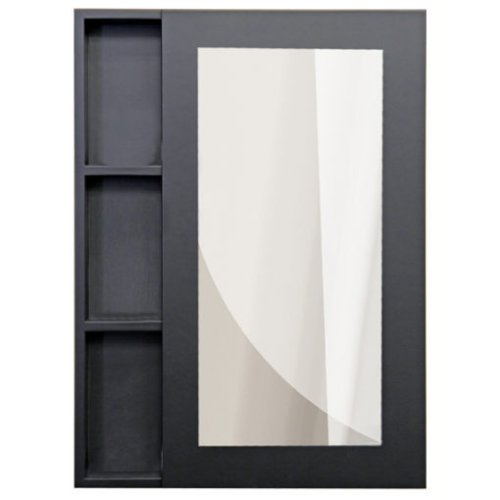 Above: tricom mirror cabinet – mahogany
Above: tricom mirror cabinet – mahogany
Mirrored Cabinet: These come with a mirror door along with the storage. These are usually mounted above the sink and help with daily routines such as brushing your teeth, shaving, grooming, etc.

Above: mirror cabinet aluminium
Medicine Cabinet: These have larger storage space and area popular choice for bathrooms. The purpose of these units is usually to store medicine and other toiletries like soaps, shampoos, and lotions.
- Corner Cabinet: These are small compact units mounted on the corner of two adjoining walls. These have considerably less storage space as it is meant to fit in a smaller area. These are best suited for smaller bathrooms.
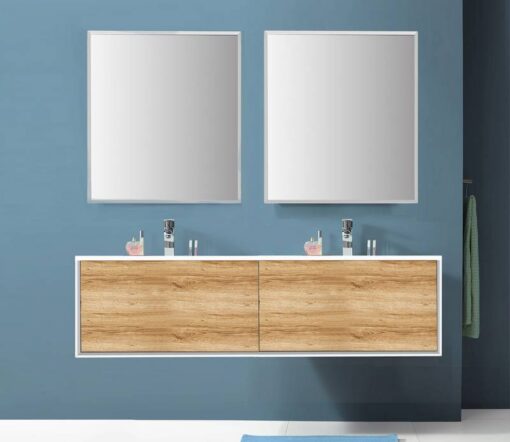 Above: Cara oak gloss vanity & ceramic basin
Above: Cara oak gloss vanity & ceramic basin
Size
Size is another factor to consider before choosing the right cabinet for the bathroom.
As these come in various storage sizes, there are several options to choose from depending on your exact requirement.
The storage size can be determined by considering available space, the number of family member, and the daily use of products.
Make sure to choose the right size, as bulky cabinets could spoil the look of the existing interiors.
Cabinets are subject to more wear and tear, especially in the family used bathrooms. This means that, guest bathrooms are used on a more occasional basis so the fixtures there may last longer. Do a thorough inspection of all the bath cabinets in your home and decide which ones need a renovation.
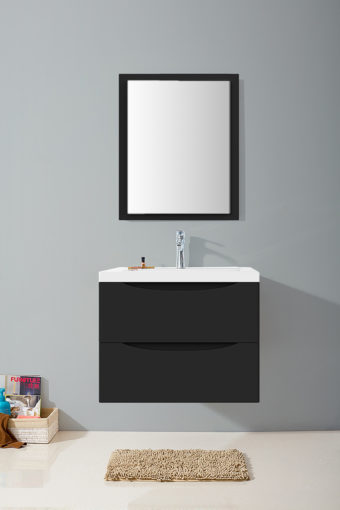
Above: Romi black matt vanity soft closing mdf & art basin
Position
Position of the unit is one of the major factors to consider before buying a cabinet.
Positioning it properly will help to better utilize the available space giving it a more organized look.
More modern units require power for its inbuilt lighting and power sockets, and thus require to be positioned near an available power source.
Whatever your project requires, our knowledgeable Tiletoria sales team are eager to assist you. Please contact your closest showroom to find the perfect cabinet for your renovation.


